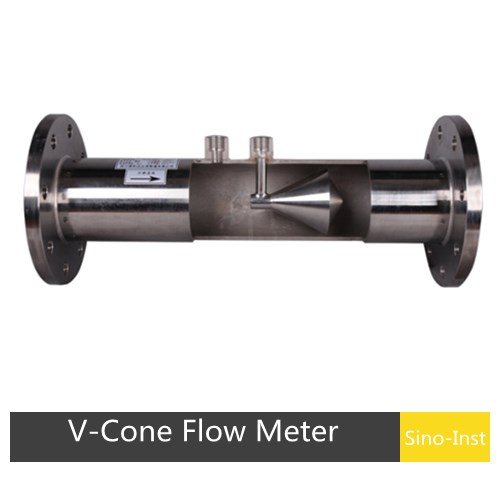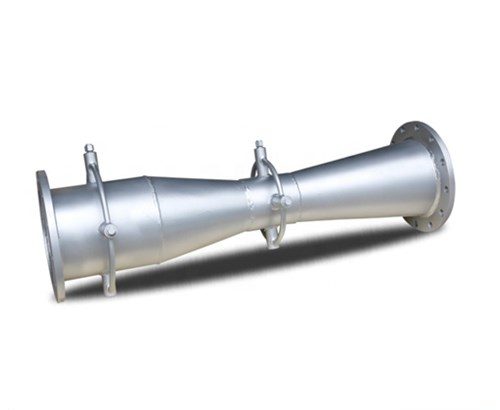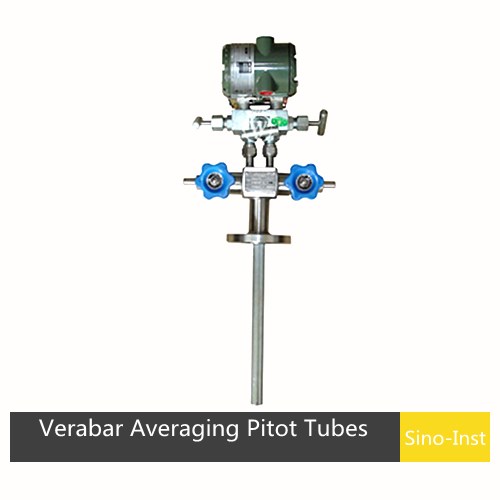Target flow meters also known as drag force flow meters. Insert a target (drag element), usually a flat disc or a sphere with an extension rod, into the flow field. They then measure the drag force on the inserted target and convert it to the flow velocity. The structure of target type flowmeter: a measuring tube (housing), a new capacitive sensor, a choke, an integrated display and an output part. The target type flowmeter has the characteristics of high accuracy. Capable of measuring various media. For example: water flow, fuel oil, liquid diesel, air flow measurement.
SI-3706 target type flowmeter supports local display; 4 ~ 20mA two-wire system; pulse 0 ~ 5V; RS485 / RS232; GPRS wireless remote transmission; HART, etc.
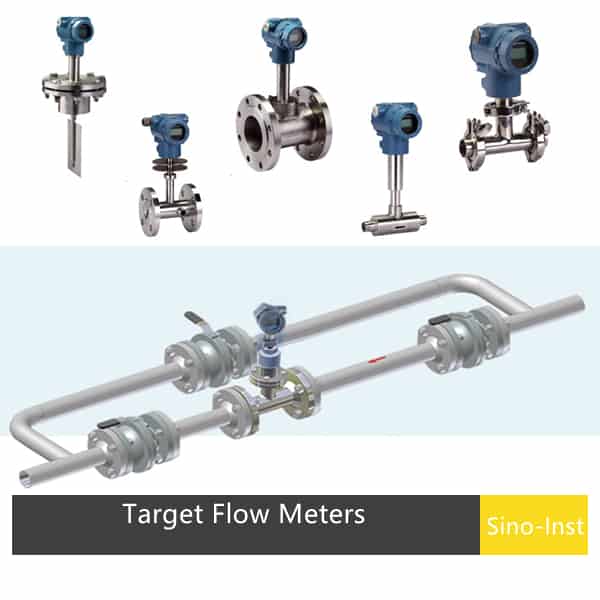
| Diameter | Φ10 ~ Φ2000, larger pipe diameter can be customized |
| Temperature | -196°C ~ 500°C |
| Pressure | 0~42MPa |
| Medium | gas, liquid (including high viscosity liquid, slurry), steam; |
| Velocity of flow | Suitable for low-velocity media, its measurable minimum flow rate is 0.08m / s |
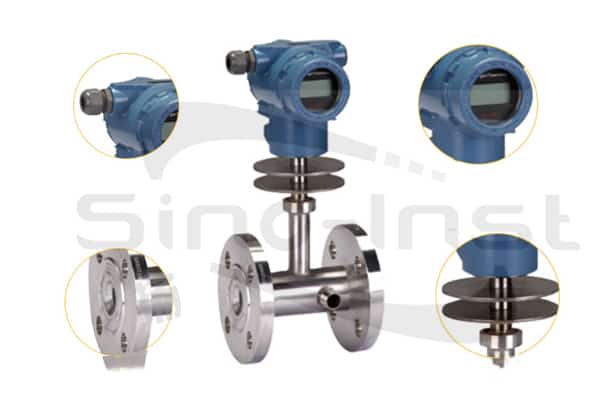
- The whole instrument has a solid structure without moving parts. Easy to disassemble;
- Can choose a variety of anti-corrosion and high and low temperature resistant materials. Such as Hastelloy, titanium, etc;
- The whole machine can be made fully sealed without dead corners (welded form). Without any leakage points, and can withstand 42MPa high pressure;
- Small pressure loss, only about 1/2 △ P of standard orifice plate;
- Strong anti-interference and anti-impurity capabilities;
- The instrument has a self-checking program, and the failure phenomenon is clear at a glance;
- The sensor is not in contact with the measured medium, there is no component wear, and it is safe and reliable to use;
- Dry calibration method can be used in situ, that is, weight hanging method. One-button operation can complete the calibration;
- There are multiple installation methods to choose from, such as online plug-in, low installation costs;
- With integrated temperature and pressure compensation, direct output quality or standard square;
- Optional small signal removal, non-linear correction, and filtering time can be selected;
- It can accurately measure the gas and liquid flow under various normal temperature. High temperature 500 degrees, and low temperature -200 degrees;
- Accurate measurement, accuracy can reach 0.2%;
- Good repeatability, generally 0.05% to 0.08%, fast measurement;
- Can change the range of resistance (target) according to actual needs;
- Low-power battery on-site display, can directly read the displayed value online. And the display can read the instantaneous and cumulative flow and percentage bar graph at the same time;
- Simple and convenient installation and extremely easy maintenance;
- Multiple output formats, which can transmit various parameters remotely;
- Strong vibration resistance, pulsating flow can be measured within a certain range.
Sino-Instrument offers Capacitive target flowmeter. Capacitive target flowmeter is a new type of capacitive force inductive flowmeter. Developed on the basis of traditional target flowmeter. And developed with new sensors and microelectronic technology. It has both orifice plate and vortex flowmeters. The characteristics of no moving parts. High sensitivity, accuracy comparable to volumetric flow meters, and a wide range. The use of a chip-level capacitive force sensor and an efficient anti-overload structure design are the key cores for the new product to achieve high precision and high stability. In addition, it has unique anti-interference and anti-impurity performance. Our capacitive target flow meters can replace the conventional flow measurement. It has a good adaptability to the difficult flow measurement conditions. Such as high viscosity, dirty media, easy to set and block, high temperature, low temperature, and strong corrosion. It is widely used in petroleum, chemical industry, metallurgy, power. Pharmaceutical, environmental protection, food and other fields.
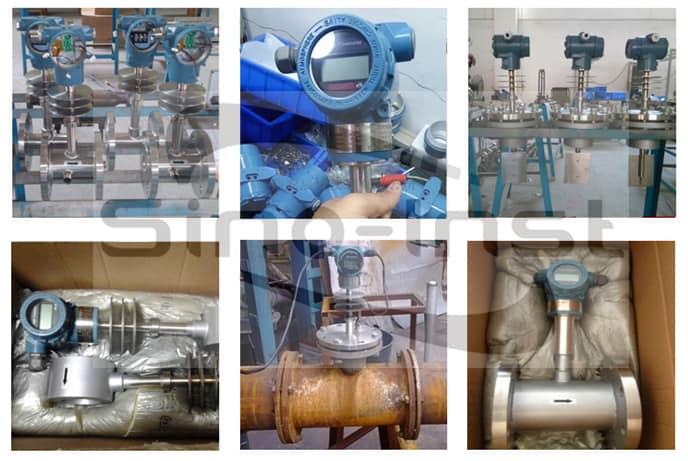
| Medium | Liquid,Gas and Steam | ||||||
| Caliber | Pipe type | Clamp type | Insertion type | ||||
| 15~300mm | 15~600mm | 100~2000mm | |||||
| Pressure | 0.6~10MPa | 0.6~42MPa | 0.6~42MPa | ||||
| Medium Temperature | -196°C~+450°C ( Confirming the temperature range before purchase) | ||||||
| Precision | ±0.2% | ±0.5% | ±1.0% | ±1.5% | ±2.5% | ||
| Range | 1:03 | 1:05 | 1:10 | 1:10 | 1:10(Steam) | ||
| Compensation | Temperature compensation; Pressure compensation | ||||||
| Repeatability | 0.1%~0.08% | ||||||
| Power Supply | 3.6V lithium battery, 24V DC | ||||||
| Output | LCD display, and 4~20mA, 0~10V, impulse or RS485 (Optional) | ||||||
| Material of measure tube | Carbon Steel;304;316L; Being able to provide other according to user requests | ||||||
| Explosion- Prevent Symbol | ExiallCT4, ExiallBT4 | ||||||
| Flange specifications | The flange specifications of the flow meter are in accordance with GB / T series standards, and can also be specially processed according to user requirements. | ||||||
| Protection class | IP65; IP67 | ||||||
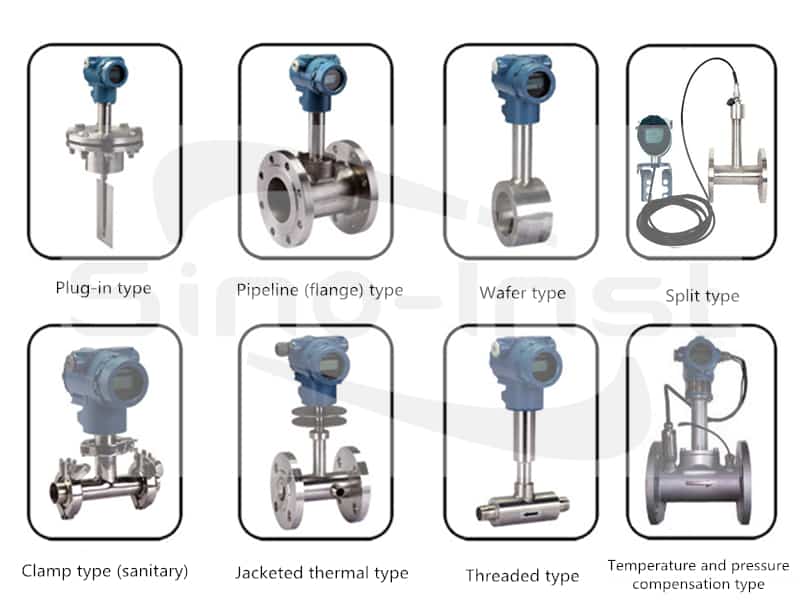
SI-3706 Target Flow Meter has various connection methods to meet your various measurement needs. According to different connection methods, target flowmeters can be divided into:
Pipe flange target flowmeter
Clip-on target flowmeter
Plug-in target flowmeter
Conical Threaded Target Flowmeter
Sanitary clamp type target flowmeter
Split target flowmeter
Jacket insulation target flowmeter
Temperature and pressure compensation target flowmeter
If you don’t know how to choose the right target flowmeter, please contact our sales engineer.
Sino-Inst provides free technical support.
SI-3706 target type flowmeter is a new type of capacitive force inductive flowmeter. It has the characteristics of no moving parts such as orifice plates and vortex flowmeters. And has high sensitivity, which is comparable to volumetric flowmeter accuracy, wide measuring range. The use of a chip-level capacitive force sensor and an efficient anti-overload structure design are the key cores of the new product to achieve high precision and high stability. The unique anti-interference and anti-impurity performance, in addition to replacing the flow that can be measured by conventional flow Measurement problems. Especially in high viscosity, dirty media. Easy to set and clogging, high temperature, low temperature, strong corrosion and other difficult to measure flow conditions have a good adaptability. Widely used in petroleum, chemical, metallurgical, power, pharmaceutical , Environmental protection, food and other fields.
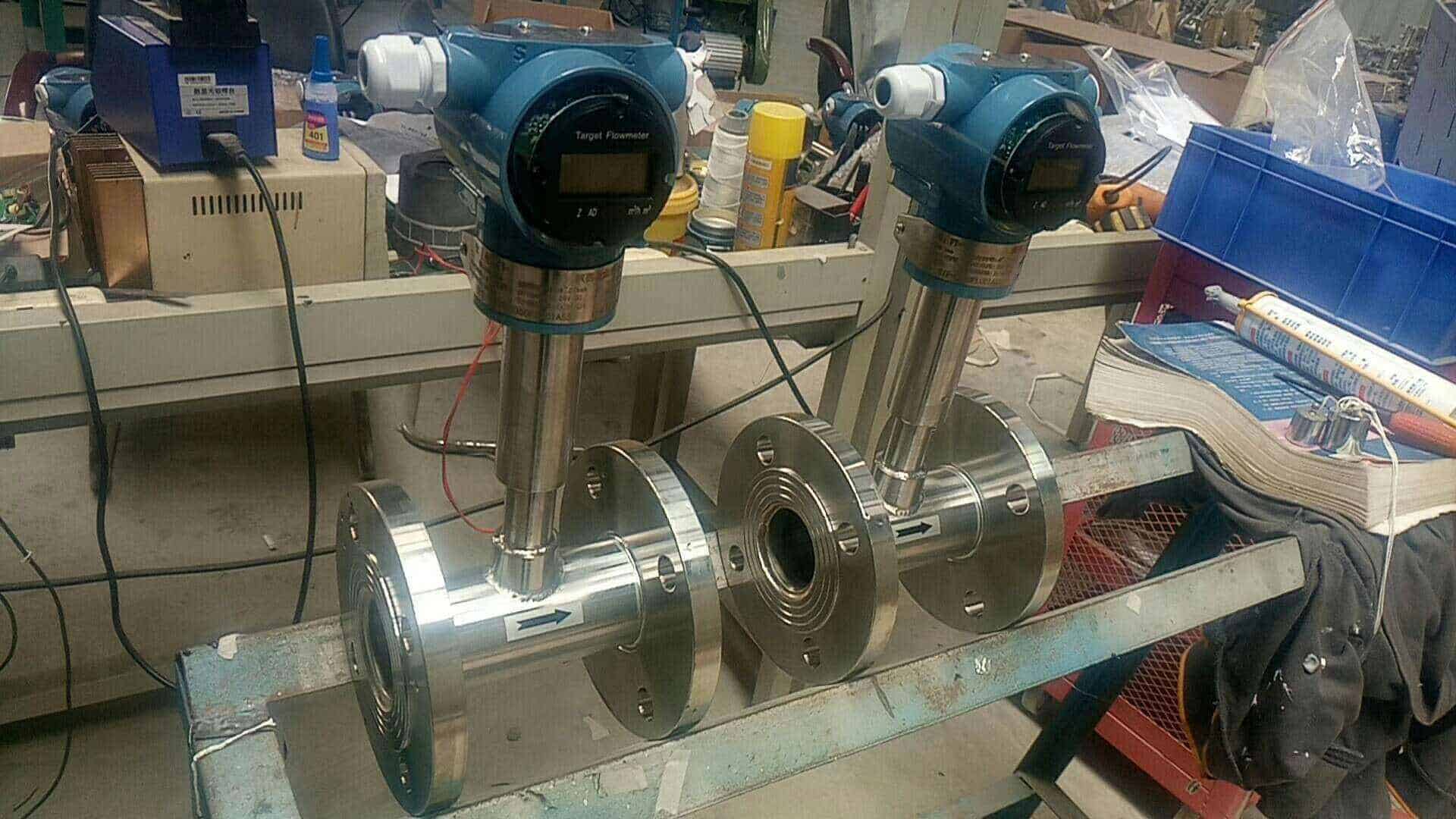
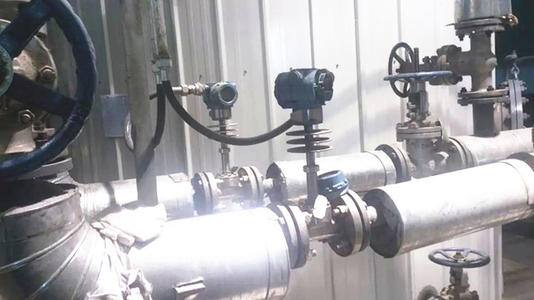
Gas:
gas, air, hydrogen, natural gas, nitrogen, liquefied petroleum gas.
Hydrogen peroxide, flue gas, methane, butane, chlorine, etc.
Liquids:
heavy oil, paraffin, asphalt, sulfuric acid.
Cooking oil, residue oil, acetone, diesel, mine water, detergent, soy sauce, gasoline, silicone oil.
Syrup, solvent, perfume, sea water.
Aviation kerosene, soap ketone water, glucose, canolaic acid, salt water, paste, ink, coolant.
Glycol, mineral oil, liquid sugar, hydrochloric acid.
Automotive coatings, resin, butter, vegetable oil, liquid oxygen, shampoo, toothpaste, gel.
Fuel, milk, bleach, conditioner, soda, additive.
Cleaning agent, alkaline, ammonia, marine oil, chemical reagent, kerosene,
Glycerin, dye, water, nitric acid.
High boiling point organic solution, lard, alcohol, oil, ethylene, polypropylene, methylbenzyl, etc.
Steam:
Superheated steam, saturated steam.
- They are useful for difficult measurements. Such as slurries, polymer bearing and sediment-bearing materials corrosive mixtures, etc.
- They provide good accuracy when calibrated for specific streams.
- They are good for relatively high temperatures and pressures.
- Low initial set up cost
- Can be used with a wide variety of fluids, even viscous fluids and slurries.
- Can be used in abrasive, contaminated, or corrosive fluid flow
- Can be made to measure flow velocity that is sporadic or multi-directional with sphere drag element designs
- Can be used for any type of liquid, gas, or steam cryogenics.
- There is no moving parts such as bearings, to wear out causing failures.
- High reliability where life tests have been made to 20,000,000 cycles.
- Can be used for any line size from 0.5 inches and up with any type of mounting.
- Range/fluid changes accomplished by simply changing targets.
- Turndowns aprox.15:1
- Several materials are available. Among them 303/304 SS, 316 SS, hastelloy and inconel.
- Calibration must be verified in the field.
- Pressure drop is inevitable due to the rod and the drag element
- In-line mounting required in these flowmeters.
- They have a limited calibration data.
- In case of target flowmeters no-flow conditions must exist for zeroing
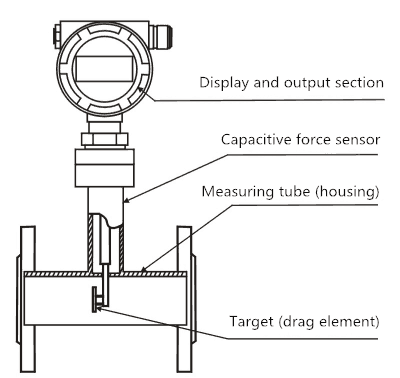 Capacitive target flowmeter is mainly composed of measuring tube (shell), new capacitive force sensor, choke piece, integrated display and output part.
Capacitive target flowmeter is mainly composed of measuring tube (shell), new capacitive force sensor, choke piece, integrated display and output part.
Target flowmeters measure flow by measuring the amount of force exerted by the flowing fluid on a target suspended in the flow stream.
The force exerted on the target by the flow is proportional to the pressure drop across the target.
Similar to differential pressure flowmeters, Bernoulli’s equation states that the pressure drop across the target (and hence the force exerted on the target) is proportional to the square of the flow rate.
Using this relationship, 10 percent of full scale flow produces only 1 percent of the full scale force. At 10 percent of full scale flow, the target flowmeter accuracy is dependent upon the transmitter being accurate over a 100:1 range of force.
Transmitter accuracy is typically degraded measuring low forces in its range, so flowmeter accuracy can be similarly degraded.
So, this non-linear relationship can have a detrimental effect on the accuracy and turndown of target flowmeters. Remember that of interest is the accuracy of the flow measurement system — not the accuracy of the transmitter.
When the medium flows in the measuring tube, the pressure difference caused by its own kinetic energy passing through the blocking member (target). And has a force on the blocking member. The magnitude of the force is proportional to the square of the velocity of the medium.
The mathematical way is as follows:
F = CdAρ • V2 / 2
In the formula: F —— the force of the choke (kg)
Cd-object resistance coefficient
A ——Axial projection area of the choke on the measuring tube (mm2)
ρ ——Density of medium under working conditions (kg / m3)
v-average flow velocity of the medium in the measuring tube (m / s)
The force F received by the choke member (target) is transmitted to the capacitive force sensor via a rigidly connected transmission member (stem).
And the capacitive force sensor generates a voltage signal output:
V = KF
In the formula:
V——Voltage output by the capacitive force sensor (mV), K——Proportional constant, F——The acting force of the choke (target)
So, after the voltage signal is pre-amplified, AD converted. And processed by the computer. The corresponding instantaneous flow and cumulative total can be obtained.
- Target flowmeters inferentially measure the flow of liquids and gases. Such as water, air, industrial gases, and chemicals.
- Be careful using target flowmeters on fluids that can coat the target. Because the flowmeter accuracy can be degraded.
- This flowmeter can be applied to sanitary, cryogenic liquids, relatively clean, and corrosive liquids.
- Thematerials of construction of all wetted parts, including the flowmeter body and seals, should be considered.
- Inline target flowmeters are available up to approximately 6 inches in size.
- Insertion target flowmeters are available for larger line sizes.
- Applications requiring sanitary piping systems are often found in the pharmaceutical and chemical industries. Such as in the manufacture of drugs and vitamins.
- Sanitary applications are especially prevalent in the food and beverages industry where cleanliness is important.
- Applications for target flowmeters are found in the mining, mineral processing, pulp and paper, power, petroleum, chemical, and petrochemical industries.
- Common applications include the measurement of process and cooling water flows.
- Be careful when operating target flowmeters low in their flow range. Because accuracy can be compromised at these flow rates.
- Avoid abrasive fluids. Because the target can be damaged and measure inaccurately.
- Fluids that coat the target can cause it to become heavy. Such that the force measurement can become inaccurate and unresponsive to flow changes.
- These flowmeters should not be applied to slurries and high viscosity liquids.
- Calibration is an important part of ensuring accurate operation of target flowmeters.
- Pressure effects, physical effects, and flowmeter orientation can affect the zero adjustment of target flowmeters.
- After calibrating the target flowmeter (typically with weights), be sure to zero target flowmeters after installation with a full pipe under no flow conditions. To ensure compensation for these effects in the final installation.
- This procedure also compensates for the calibration shift that can occur when the orientation of the flowmeter during calibration is different than its installed orientation.
- In general, in-situ zero adjustment should be performed after re-installing target flowmeters.
- Operating a target flowmeter above its maximum flow rate can cause the calibration to shift and potentially damage the suspension system of the flowmeter.
- Note also that operating target flowmeters continuously for extended periods of time can cause a mechanical shift to occur that can affect the zero. Because the target may not return to exactly the same position after being exposed to forces over time.
- Rapidly changing flow, such as slug flow conditions, two-phase flow, and start-up conditions (gas to liquid transitions). Can similarly affect the mechanics of the target flowmeter and hence its zero. Therefore, it is advisable to periodically verify the zero adjustment of target flowmeters.
| SI-3706 Target Flow Meter | ||||||||||||||||||||||||||||||
| Code | Diameter | |||||||||||||||||||||||||||||
| 0010 | DN10 | |||||||||||||||||||||||||||||
| 0100 | DN100 | |||||||||||||||||||||||||||||
| …… | ||||||||||||||||||||||||||||||
| 5000 | DN5000 | |||||||||||||||||||||||||||||
| Code | Connection | |||||||||||||||||||||||||||||
| F | Pipe flange type | C | Plug-in type | D | Clamp type | U | Continuous flow disassembly | L | Threaded type | E | Others | |||||||||||||||||||
| Code | Medium | |||||||||||||||||||||||||||||
| L | Liquid | G | Gas | S | Steam | |||||||||||||||||||||||||
| Code | Pressure | |||||||||||||||||||||||||||||
| A | 0.6 Mpa | E | 2.5 Mpa | I | 10 Mpa | M | 20Mpa | |||||||||||||||||||||||
| B | 1.0 Mpa | F | 4.0 Mpa | J | 11 Mpa | N | 25 Mpa | |||||||||||||||||||||||
| C | 1.6 Mpa | G | 5.0 Mpa | K | 15 Mpa | O | 26 Mpa | |||||||||||||||||||||||
| D | 2.0 Mpa | H | 6.3 Mpa | L | 16 Mpa | P | 42 Mpa | |||||||||||||||||||||||
| Code | Temperature | |||||||||||||||||||||||||||||
| C | -20 ~ 80°C | |||||||||||||||||||||||||||||
| Z | 80~ 200°C | |||||||||||||||||||||||||||||
| G | 200~450°C | |||||||||||||||||||||||||||||
| D | -200~-20°C | |||||||||||||||||||||||||||||
| Code | Output | |||||||||||||||||||||||||||||
| P | Pulse output | H | HART | |||||||||||||||||||||||||||
| I | 4~20mA | K | Switch output | |||||||||||||||||||||||||||
| R | Communication output | |||||||||||||||||||||||||||||
| Code | Explosion-proof mark | |||||||||||||||||||||||||||||
| A | Intrinsic safety | D | Flameproof | |||||||||||||||||||||||||||
| Code | Shell material | |||||||||||||||||||||||||||||
| C | Carbon steel | |||||||||||||||||||||||||||||
| S | 304 stainless steel | |||||||||||||||||||||||||||||
| T | 316L | |||||||||||||||||||||||||||||
| Code | Sensor material | |||||||||||||||||||||||||||||
| H | Hastelloy | |||||||||||||||||||||||||||||
| T | titanium | |||||||||||||||||||||||||||||
| S | 304stainless steel | |||||||||||||||||||||||||||||
| E | Specific material | |||||||||||||||||||||||||||||
The target type flowmeter is suitable for a variety of occasions and measurements of various media. In order to ensure satisfactory results, it is recommended to pay attention to the following when selecting a model:
1) Determine the required common flow, and determine the maximum flow by 1.5 to 2.5 times the common flow.
2) Specify the standard of the mounting flange and the form of seal, especially for special installation requirements.
3) When ordering, the user should indicate the medium of the fluid to be tested and give the density of the medium.
4) If you need to measure special media, you can directly recommend the required measuring tube materials in addition to the measuring tube materials provided by the company.
1.Flanged pipeline type
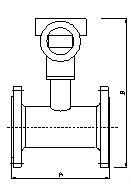
| DiameterDN(mm) | Total width | Total height | DiameterDN(mm) | Total width | Total height |
| A | B | A | B | ||
| 15 | 150 | 345 | 125 | 200 | 455 |
| 20 | 150 | 350 | 150 | 200 | 480 |
| 25 | 150 | 355 | 200 | 250 | 530 |
| 32 | 150 | 362 | 250 | 250 | 580 |
| 40 | 150 | 370 | 300 | 250 | 630 |
| 50 | 150 | 380 | 350 | 250 | 680 |
| 65 | 200 | 395 | 400 | 250 | 730 |
| 80 | 200 | 410 | 450 | 250 | 780 |
| 100 | 200 | 430 | 500 | 250 | 830 |
2. Wafer type

Diameter DN(mm) | Total width | Total height | Diameter DN(mm) | Total width | Total height |
| A | B | A | B | ||
| 15 | 66 | 270 | 125 | 66 | 380 |
| 20 | 66 | 275 | 150 | 66 | 405 |
| 25 | 66 | 280 | 200 | 66 | 455 |
| 32 | 66 | 287 | 250 | 66 | 505 |
| 40 | 66 | 295 | 300 | 66 | 555 |
| 50 | 66 | 305 | 350 | 66 | 605 |
| 65 | 66 | 310 | 400 | 66 | 655 |
| 80 | 66 | 335 | 450 | 66 | 705 |
| 100 | 66 | 355 | 500 | 66 | 755 |
3.Plug-in type
a. Fixed
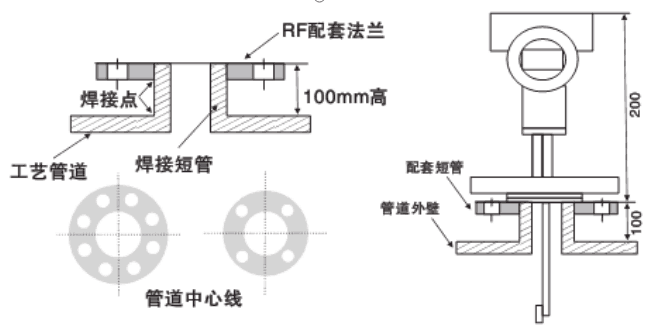 The nominal diameter of the connecting short pipe and flange is DN100mm, the liquid is DN50mm, the flange specifications are GB 1.6MPa, 2.5MPa, 4.0MPa, and the sealing surface is RF.
The nominal diameter of the connecting short pipe and flange is DN100mm, the liquid is DN50mm, the flange specifications are GB 1.6MPa, 2.5MPa, 4.0MPa, and the sealing surface is RF.
b. Online detachable
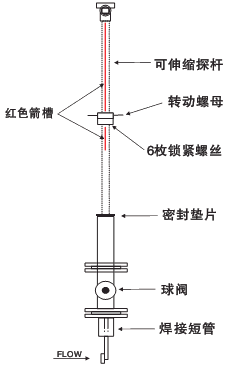
Installation method
- Normal temperature type, low temperature type, high temperature type flowmeter adopts horizontal, vertical or inverted installation depending on different working conditions (subject to the factory calibration list);
- When the working temperature of the medium is above +300 degrees, the user should take thermal insulation measures to prevent the meter head from being damaged by heat radiation (the working temperature of the meter head is -30 to +70 degrees), and the working temperature is below -100 degrees. Medium, also need to take antifreeze measures;
- In order to ensure the accurate measurement of the flowmeter, it is required to set straight pipe sections before and after;
- In order to ensure that the flowmeter does not affect the system work during inspection and replacement, try to set bypass valves (3) and shut-off valves (1, 2);
- Due to process requirements, vertical installation can be adopted, and the flow direction of the measured medium can be from bottom to top or from top to bottom, but the supplier should be explained when ordering;
- The diameter of the flowmeter is the same as the diameter of the connected pipe to reduce flow interference and cause measurement errors;
- The flowmeter housing must be reliably grounded. If there is no grounding condition, it should be explained to the factory.
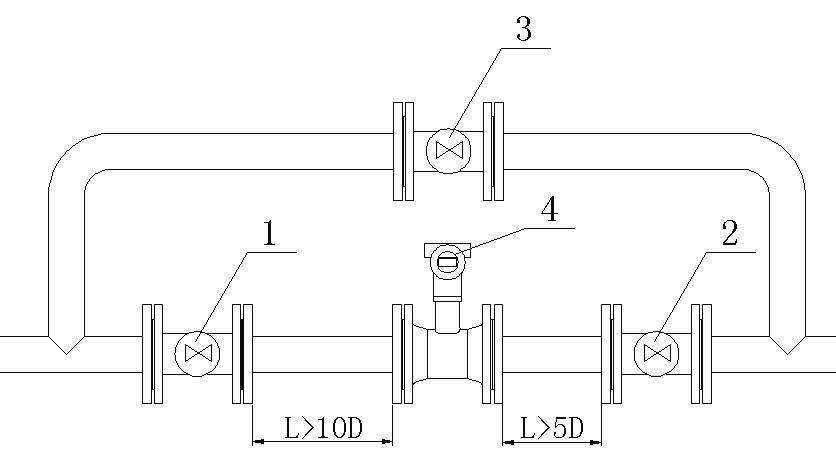
1, 2 and 3 are the front and rear valves and bypass valves respectively; 4 is the flow meter, L ≥ 10D and L ≥ 5D are the lengths of the front and rear straight pipe sections, respectively, and D is the nominal diameter of the pipeline.
What are the different types of flow meters?
Flow Metering Principals
- Differential Pressure Flowmeters
- Velocity Flowmeters
- Positive Displacement Flowmeters
- Mass Flowmeters
- For Open Channel Flowmeters – weirs, flumes, submerged orifices, current meters, acoustic flow meters and more
For different working principle, We offer different types of flow meters, like:
Differential Pressure Flow Meters
Orifice Plate
Venturi Tube
Flow Nozzles
The Sonic Nozzle – Critical (Choked) Flow Nozzle
Calorimetric Flowmeter
Ultrasonic Doppler Flowmeter
Positive Displacement Flowmeter
Variable Area Flowmeter or Rotameter
Velocity Flowmeters
Pitot Tubes
Turbine Flowmeter
Thermal Flowmeter
Coriolis Flowmeter
Open Channel Flowmeters
How does a turbine flow meter work?
How does a vortex flow meter work?
Vortex flow meters are suitable for measuring steam as well as a variety of liquids and gases. As fluid moves across a vortex meter shedder bar, vortices form. The frequency of the vortices shedding is proportional to the fluid velocity.
Even for the steam flow rate, Vortex flow meters are the perfect choice. Pressure and Temperature compensation ensure measurement accuracy. When measure steam or gas flow in pipes with variable operating pressure and temperature.
Applications in the chemicals and petrochemicals industries. For example, in power generation and heat-supply systems. Involve widely differing fluids: saturated steam, superheated steam, compressed air. Nitrogen, liquefied gases, flue gases, carbon dioxide, fully demineralized water. Solvents, heat-transfer oils, boiler feedwater, condensate, etc.
What does a Coriolis meter measure?
Do you want to learn more about measurement technology for Coriolis mass flow meters? We will discuss and explain various measurement techniques for Coriolis mass flow meters.
Coriolis mass flow meter also called micro motion flow meter. Coriolis mass flow meter is the mass flow meter beasd on the coriolis force. Coriolis mass flow meter and thermal mass flow meter are the most common mass flow meters. Corolis mass flow meters are best choice for all process and custody transfer (CT) applications. Coriolis mass flow meter can measure different values at the same time. Mass, volume flow, density and concentration measurement of liquids and gases. This is the most important difference among Coriolis mass flow meter, DP and oval gear flow meters.
Techincal Support
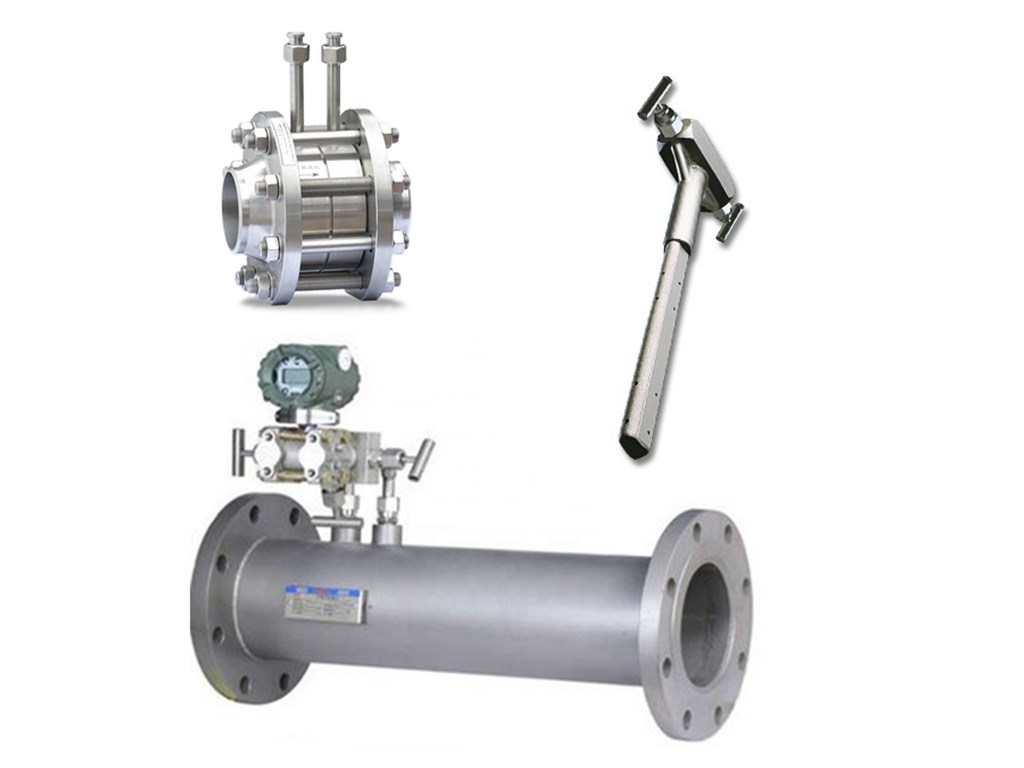
Differential Pressure Flow Meter Technology
Differential Pressure Flow Meters also called DP flow meters. Differential pressure flow meters consist of flow sensors and pressure/differential transmitters. DP Flow Meters measure the flow rate based on the differential pressure measured by the flow sensor parts. Flow sensors are the important part of differential pressure flow meters. Like: Orifice plate, Venturi tube, Wedge, V-cone and Averaging Pitot Tubes. Differential pressure (DP) flow meters are suitable for applicaitons, like: water, gas, steam, oil….
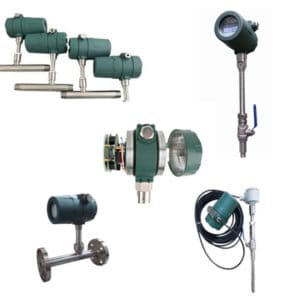
Thermal Mass Flow Meter Technology
Thermal Mass Flow Meter (TMF) also called Thermal Flow Meter. Thermal Mass Flow Meters measure the mass flow of a fluid. An external heat source will heat the pipe or the fluid. Temperature field changes when the fluid flows through the pipe. Thermal mass flow meter measures the relationship between the energy required to increase the temperature of a fluid and the mass of the fluid to measure the mass flow of the fluid. The flowmeters directly measure the mass flow or normalized volume flow of gases. Without any additional pressure and temperature compensation. Generally, thermal mass flow meter used to measure the mass flow of a gas (like natural gas).
-1.jpg)
